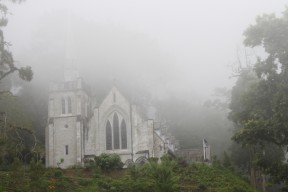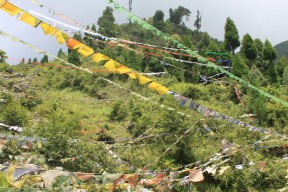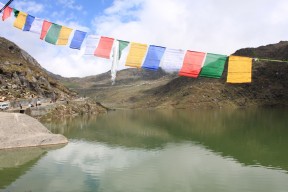Since I belong to the mountains, I speak for them but this might just hold true for other places in the world too. The memories you come back with depend upon the season you go in. For me, the mist is the most overpowering impression of Sikkim in pre-monsoon June. It seeps through the fir trees, through dense orchid laden forests and between clefts in the mountain tops. It wafts in the breeze like a swaying curtain of grey, finds you wherever you are and puts its arms around you like an old friend.
It blurs the stern outlines of monasteries that stand in solitary grandeur on the top of hills, places beads of dampness on the rich maroon robes of little boy lamas, touches the cheeks of fat babies sleeping in the cozy knot of fabric slung around their mothers’ backs and fills the fur of lazy Bhotia dogs sprawled outside roadside beer and momo shacks, adding a musty smell if you go close enough and take a deep breath.
For a week or more, we treaded on the toes of Mount Kachenjunga, leaving behind foot marks in the damp grass but we never got to see its handsome face, however much we craned our necks. The mist had found it before us and wrapped it in possessive haze. So Tenzing’s Kachenjunga was a no show unless you’d like to count the beautiful oil painting of those snow covered peaks that hangs in the EME Officers Mess at Kalimpong. Set up in an old English time bungalow with orange spider lilies blooming along the sidewalk and thick green ivy climbing up the old stone walls, the Mess is a heritage site in itself.
But, I’ll save that for another article. For me, the most fascinating thing about Sikkim are its people – the school guard whose smile reaches so deep into his crinkling eyes that it almost closes them shut; the feisty old lady who introduces herself as Buddhi and blows bubble gum balloons as she sits hawking her wares in the Sunday haat in Lal Bazaar, Gangtok; the taxi driver smelling suspiciously of channg at 10 in the morning, who laughs off our complaint that he doesn’t have good Nepalese songs in his car, turns his head around (yes, while still driving) and silences us by singing the romantic Rato Rani phule jhai sanjha ma, timi phulyo kaleji majhaa maa (the flower Raat ki Rani blooms in the dusk, but you bloom in my heart).
As the SUV picks us up at Bagdogra airport and winds up the curves to Kerseong, bypassing fresh green Sal forests, tea plantations and women selling piles of hot roasted corn on the cob at the roadside; the air starts getting cooler. Soon the tracks of the toy train to Ghoom (an aptly named curve in the road a few kilometers before Darjeeling) start running alongside. Wayside shacks sell tea and chips that you can have sitting on the train tracks. Though the train has not been running for a year because of a landslide enroute, even when it does, it moves so slow that there is time to blow on your tea, dunk a milk biscuit in and get up at a leisurely pace when you see it heading in your direction.
Stephen Hawking might not agree but fact is that time slows down as you reach closer to the Himalaya. Wherever you look you find people looking back at you with a friendly twinkle in their eyes. Yes, they have the time. They sit outside their little houses in Bermudas and slippers, holding babies in their arms, alongside sleepy dogs and rich pink and red begonias growing from rusting cans on the window sills, at peace with the world. We spot young boys play carrom along the toy train tracks, board balanced on an upturned bucket.
Little girls with bright yellow ribbons knotted into large flowers in their pigtails skip rope outside their houses. And proud mamma hens with Bianca Castafiore bosoms waddle across train tracks with a retinue of chirping chicks, completely ignoring the rooster’s disapproving crowing from a tin roof, like any seasoned wife. She might eventually end up inside a momo but then most of us will also finally find ourselves roasting in a burning fire or inside a deep pit. That’s no reason why life cannot be enjoyed while it is still smiling in our faces, right?
Darjeeling is thickly populated with tourists, their loud chatter pierces the eardrums and their cars belch smoke into the air. They create such a mess that I would like to dissociate completely from it all and if you are planning a visit in the tourist season, I’d like to hold you back by the arm and say: “Please don’t go!” An untidy mesh of wires droops across streets and traffic jams are a painful norm. Once upon a time, Darjeeling must have been a beautiful hill town. Now, she is a worn out town gasping for breath under an overload of insensitive visitors and garbage.
Signs of the beauty it must have once possessed show only in the upper reaches beyond where the hotels and the market end. If you really want to see that, walk up the narrow twists and turns in the road high up to where the Cantonment begins and St Paul Boarding School (where Sushmita Sen sizzled in sexy chiffons for Shahrukh Khan’s Main Hoon Naa) stretches itself into a lazy yawn on the hillside since it’s summer vacation time and the boys have all gone home. This is where you find lilies sprouting by the wayside, wild red roses ambling up wood houses and bright blue Hydrangea peeping from behind shiny dark green leaves. Up in the cantonment, a hillside of undulating green unfolds before you.
Occasionally, you run into wrinkled old men with umbrellas hanging from curved handles tucked into the back of their collars, a serious walker who reads a newspaper while he walks, who has probably been doing it for so many years that he does not even bother to look up at the winding turns in the road, an Army officer’s labs in black, brown and white unimaginatively named Blackie, Brownie and, well, Kanchi, which means young girl in Nepali. And speaking of Kanchis, you also run into young girls with perfect curves and salty faces and drop dead gorgeous smiles that can stop you in the tracks if you happen to be male.
We go down then to the town for a taste of thupka and momos, try some Dansberg beer brought from the factories of the film star Danny Denzongpa, sample the Death by Chocolate pastries and chicken rolls of Glenary and pick up a few souvenirs from the sharp Nepali women who have set shop by the wayside. But thereafter, we return to the peace and calm of the cantonment and find a taxi that will cross the border and take us to Sikkim where prayer flags flutter overhead and the rich colours of Tibet show on ornate bus stops and exotic gompas.
Gangtok is where I find shady walkways that look like they’ll take me all the way to heaven. Since that’s not where I want to go as of now, I turn back in an hour’s time and on the walk back meet friendly kids in smart school uniforms not really in a hurry to get there, young beauties wrapped in traditional bakus with shiny black hair and complexions that can put pink roses to shame. Up in the Lingdum monastery, I run into Lamas with gentle smiles and lilting Buddhist chants that don’t mean a thing to me but still fill the senses with peace and a sense of oneness with the universe. Sitting patiently on souvenir shop shelves I find green Tara Devis and white Buddhas carved out of Yak bone dust.
In the zoo, I find sprawled Red Pandas that look like they are still nursing a hangover from Saturday evening and, yes, in my room I find a nocturnal visitor who stands there staring back at me, middle of the night and then exits through the window as I watch – hypnotized by terror. But that’s a horror story for another day. This one is a look at ramro (beautiful) Sikkim wrapped in grey mist. And that’s how we’ll let it be.
Photographs: Manoj Rawat
Rachna Bisht is a freelance writer with a career spanning 18 years with The Statesman, The Financial Express, The Indian Express and Deccan Herald. Her other passions include travelling, reading and listening to Indian classical music when not cocktailing memories with imagination to weave a debut novel. She is also a full- time mom and a gypsy Army wife. More about her on http://www.rachnabisht.com/









Absolutely gorgeously fantastic! Rachna, you make Sikkim and Darjeeling sound fantastic! I am almost regretting not going there when my dad was posted in Sikkim! Thanks for a beautiful post!
Thanks for your comment Tina. There can always be another holiday. And more fun if dad is not around 🙂
Great read Rachna…i thoroughly enjoyed it…had been to Sikkim a few years ago and ventured on an ambitious trip to Lake Gurudongmar. heaven was no more an imagination there:
You write beautifully. Look forward to reading more of your stuff:)tc
Glad you enjoyed it Insia. thanks